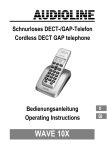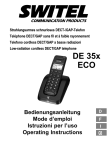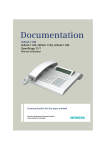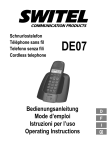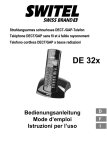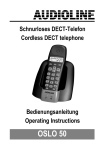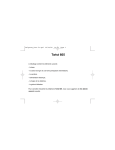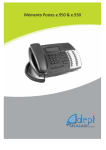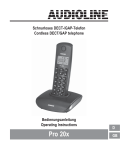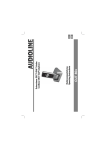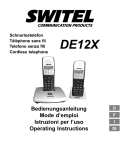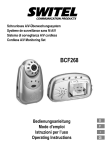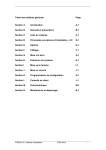Download DE 26X - Switel
Transcript
Schnurloses DECT−/GAP−Telefon Téléphone sans fil DECT GAP Telefono cordless a standard DECT−GAP Cordless DECT GAP telephone DE 26X Bedienungsanleitung Mode d’emploi Istruzioni per l’uso Operating Instructions D DE 261 Bedienungsanleitung . . . . . . . . . . . . . . . . . . 3 Mode d’emploi . . . . . . . . . . . . . . . . . . . . . 21 Istruzioni per l’uso . . . . . . . . . . . . . . . . . . . 39 Operating Instructions . . . . . . . . . . . . . . . . 57 Declaration of Conformity . . . . . . . . . . . . . . 76 1 1 2 3 4 5 6 7 8 9 10 11 Inhaltsverzeichnis Sicherheitshinweise . . . . . . . . . . . . 4 Telefon in Betrieb nehmen . . . . . . . . 6 Bedienelemente . . . . . . . . . . . . . . . 8 Wie bediene ich mein Telefon? . . . . . 10 Menüstruktur . . . . . . . . . . . . . . . . . 13 Telefonieren . . . . . . . . . . . . . . . . . . 14 Telefonbuch . . . . . . . . . . . . . . . . . . 16 Anrufliste . . . . . . . . . . . . . . . . . . . . 16 Falls es Probleme gibt . . . . . . . . . . . 17 Technische Eigenschaften . . . . . . . . 18 Pflegehinweise / Garantie . . . . . . . . 19 3 Sicherheitshinweise 1 Sicherheitshinweise Lesen Sie diese Bedienungsanleitung sorgfältig durch. Bestimmungsgemäße Verwendung Dieses Telefon ist geeignet für das Telefonieren innerhalb eines Telefonnetzes. Jede andere Verwendung gilt als nicht bestimmungsgemäß. Eigenmächtige Veränderungen oder Umbauten sind nicht zulässig. Öffnen Sie das Gerät in keinem Fall selbst und führen Sie keine eigenen Reparaturversuche durch. Aufstellungsort Vermeiden Sie Belastungen durch Rauch, Staub, Erschütterungen, Chemikalien, Feuchtigkeit, Hitze oder direkte Sonneneinstrahlung. Verwenden Sie das Mobilteil nicht in explosionsgefährdeten Bereichen. Netzteil Achtung: Verwenden Sie nur das mitgelieferte Steckernetzteil, da andere Netzteile das Telefon beschädigen können. Sie dürfen den Zugang zum Steckernetzteil nicht durch Möbel oder andere Gegenstände versperren. Aufladbare Akkus Achtung: Werfen Sie Akkus nicht ins Feuer. Verwenden Sie nur Akkus des gleichen Typs! Achten Sie auf die richtige Polung! Bei verkehrter Polung der Akkus besteht auf der Ladestation Explosionsgefahr. Stromausfall Bei Stromausfall kann mit dem Telefon nicht telefoniert werden. Halten Sie für Notfälle ein schnurgebundenes Telefon bereit, welches ohne externe Stromversorgung arbeitet. 4 Sicherheitshinweise Medizinische Geräte Achtung: Benutzen Sie das Telefon nicht in der Nähe von medizinischen Geräten. Eine Beeinflussung kann nicht völlig ausgeschlossen werden. DECT1−Telefone können in Hörgeräten einen unangenehmen Brummton verursachen. Entsorgung Wollen Sie Ihr Gerät entsorgen, bringen Sie es zur Sammelstelle Ihres kommunalen Entsorgungsträgers (z. B. Wertstoffhof). Das nebenstehende Symbol bedeutet, dass Sie das Gerät auf keinen Fall in den Hausmüll werfen dürfen! Nach dem Elektro− und Elektronikgerätegesetz sind Besitzer von Altgeräten gesetzlich gehalten, alte Elektro− und Elektronikgeräte einer getrennten Abfallerfassung zuzuführen. Akkus entsorgen Sie beim batterievertreibenden Handel sowie bei zuständigen Sammelstellen, die entsprechende Behälter bereitstellen. Verpackungsmaterialien entsorgen Sie entsprechend den lokalen Vorschriften. 1 DECT: Digital Enhanced Cordless Telecommunication = Stan- dard für kabellose Telefone. 5 Telefon in Betrieb nehmen 2 Telefon in Betrieb nehmen Sicherheitshinweise Achtung: Lesen Sie vor der Inbetriebnahme unbedingt die Sicherheitshinweise in Kapitel 1. Verpackungsinhalt prüfen 2 Zum Lieferumfang gehören: DE 26X Inhalt DE 261 DE 2621 DE 2631 DE 2641 Basisstation mit Netzteil 1 1 1 1 Ladestation mit Netzteil − 1 2 3 Mobilteil 1 2 3 4 Telefonanschlusskabel 1 1 1 1 Akkus 2 4 6 8 Bedienungsanleitung 1 1 1 1 Basisstation anschließen Achtung: Stellen Sie die Basisstation mit einem Mindestabstand von 1 m zu anderen elektronischen Geräten auf, da es sonst zu gegenseitigen Störungen kommen kann. Schließen Sie die Basisstation wie auf der Skizze abgebildet an. Verwenden Sie aus Sicherheitsgründen nur das mitgelieferte Netzteil sowie das beigefügte Telefonanschlusskabel. Telefonanschlussdose Netzsteckdose 1 Unter www.switel.com erfahren Sie, ob dieses Telefonset be- reits erhältlich ist. 6 Telefon in Betrieb nehmen Ladestation anschließen1 Schließen Sie die Ladestation Netzsteckdose wie auf der Skizze abgebildet an. Verwenden Sie aus Sicherheitsgründen nur das mitgelieferte Netzteil. Akkus einlegen Legen Sie die Akkus in das geöffnete Akkufach ein. Verwenden Sie nur Akkus des Typs AAA NiMH 1,2 V. Achten Sie auf die richtige Polung! Schließen Sie das Akkufach. Akkus aufladen 3 Stellen Sie das Mobilteil bei der ersten Inbetriebnahme für mindestens 15 Stunden in die Basisstation / Ladestation. Haben Sie das Mobilteil richtig in die Basisstation / Ladestation gestellt, ertönt ein Hinweissignal und die Ladekontrollleuchte leuchtet. Das Mobilteil erwärmt sich beim Laden. Dies ist normal und ungefährlich. Laden Sie das Mobilteil nicht mit fremden Aufladegeräten. Der aktuelle Akkuladezustand wird im Display angezeigt: Voll Halb Schwach Leer 1 Gilt nur für Telefonsets mit mindestens zwei Mobilteilen Ver- packungsinhalt" auf Seite 6. 7 Bedienelemente 3 Bedienelemente Die Tasten Ihres Telefons werden in dieser Bedienungsanleitung nachfolgend mit vereinheitlichten Symbolen dargestellt. Leichte Abweichungen der Tastensymbole Ihres Telefons gegenüber den verwendeten Tastensymbolen sind daher möglich. Mobilteil 1 2 Display R−Signaltaste / Telefonbuch / Bestätigen 3 Auswahl aufwärts / Auswahl abwärts 4 Interngespräch / Anrufliste 5 Gespräch beenden / Löschen / 10 Mobilteil ein−/ausschalten 6 Konferenztaste / Pause 7 Tastensperre 9 8 Gespräch 8 9 Lautsprechen 7 10 Menü / Stummschaltung 1 2 3 4 5 6 Ladestation 1 1 LED Ladekontrollleuchte 1 1 Gilt nur für Telefonsets mit mindestens zwei Mobilteilen Ver- packungsinhalt" auf Seite 6. 8 Bedienelemente Basisstation 1 Paging−Taste, LED Gesprächsanzeige 1 9 Wie bediene ich mein Telefon? 4 Wie bediene ich mein Telefon? Darstellungen und Schreibweisen ë 3 Sek. Nummer eingeben Abgebildete Taste kurz drücken Abgebildete Taste 3 Sekunden drücken 5678 oder Ziffern oder Symbole im Display Symbole im Display Symbol Beschreibung 1 Interne Rufnummer des Mobilteils 05-18 Anzeige der Gesprächszeit EXT Externes Gespräch INT Internes Gespräch Die Tastensperre ist aktiviert. Das Mikrofon ist stummgeschaltet. Drei Balken: Verbindung zur Basisstation gut. Zwei Balken: Verbindung zur Basisstation weniger gut. Ein Balken: Verbindung zur Basisstation schlecht. 10 Wie bediene ich mein Telefon? Grundeinstellungen programmieren In der Grundeinstellung passen Sie die Einstellungen des Mobilteils Ihren Erfordernissen an. Zum Abbrechen drücken Sie die Taste ». Wenn Sie 15 Sek. keine Taste drücken, wird der Vorgang abgebrochen und Änderungen werden nicht gespeichert. Gehen Sie wie folgt vor: 1. Programmierung Mobilteil starten F, y/z, HandEins , ¼, 2. Lautstärke für externen Anruf y/z, Ext Vol , ¼, y/z, Vol bis Vol , ¼. 3. Lautstärke für internen Anruf y/z, Int Vol , ¼, y/z, Vol bis Vol , ¼. 4. Tonrufmelodie für externen Anruf y/z, Ext Ton , ¼, y/z, Ring bis Ring , ¼. 5. Tonrufmelodie für internen Anruf y/z, Int Ton , ¼, y/z, Ring bis Ring , ¼. 6. Sprache einstellen y/z, Sprache , ¼, y/z, ¼. 1. Programmierung Einstellung starten F, y/z, BasisEin , ¼, PIN? , ë, ¼, 2. Tonwahl / Pulswahl y/z, Wählmode , ¼, Ton / Puls , ¼. 3. Flash−Zeit y/z, Flash , ¼, y/z, lang? / kurz? , ¼. 11 Wie bediene ich mein Telefon? 4. Lautstärke der Basis y/z, B Lautst , ¼, Vol bis Vol , ¼. 5. Tonrufmelodie der Basis y/z, B Melody , ¼, B Melody bis B Melody , ¼. Werkseinstellungen wiederherstellen 1. F, y/z, BasisEin , ¼, PIN? , ë, ¼, y/z, B Reset , B Reset , ¼. Eine komplette Menüstruktur finden Sie im Kapitel 5. 12 Menüstruktur 5 Menüstruktur Menüstruktur ANRUFE TELBUCH HANDEINS BASISEIN ANMELDEN ENTANRUF EMPANRUF GEW NR HINZU BEARBEIT LOSCHEN ALLE LOS KEYTONE EXT TON EXT VOL INT TON INT VOL GERATENA SPRACHE ANTWORT PIN? (0000) B MELODY B LAUTST WAHLMODE FLASH MAST PIN B RESET SPERRE PABX BAS AUS BASISANG In das Hauptmenü gelangen Sie, wenn Sie die Taste F drücken. Danach selektieren Sie mit den Tasten y/z und bestätigen mit der ¼ Taste. 13 Telefonieren 6 Telefonieren Alle Beschreibungen in dieser Bedienungsanleitung gehen davon aus, dass sich das Mobilteil im Stand−by−Modus befindet. Gespräch annehmen º Gespräch beenden » Extern anrufen º, ë oder ë, º Wahlwiederholung º halten, y/z, º Wahl aus der Anrufliste F, ¼, y/z, ¼, y/z, Wahl aus dem Rufnummernspeicher y/z, º Intern telefonieren Î, ë Intern telefonieren 4 Interne Gespräche führen Î, ë z. B. 2. Sie müssen zwei oder mehr Mobilteile an Ihrer Basisstation angemeldet haben, um interne Gespräche führen zu können. Externe Gespräche intern weiterleiten / Konferenzgespräch Während externem Gespräch: Î, ë z. B. 2. Nachdem sich der interne Gesprächspartner gemeldet hat, übergeben Sie das Gespräch, indem Sie die Taste » drücken. Um ein Konferenzgespräch zu führen, drücken Sie, nachdem der interne Teilnehmer sich gemeldet hat, die Taste #. Sollte sich das gerufene Mobilteil nicht melden, können Sie das externe Gespräch wieder zurückholen, indem Sie die Taste Î drücken. 14 Telefonieren Weitere Funktionen Funktion Tastenfolge Mobilteil ein−/ausschalten 2 Sek. » Tastensperre ein F, * Tastensperre aus F, * Hörerlautstärke º, y/z Lautstärke Tonrufmelodie Während Klingeln y/z Mikrofon im Mobilteil stumm−/einschalten Während Gespräch F Mobilteil suchen An der Basisstation Mikrofon stummschalten Wenn Sie das Mikrofon stummschalten, kann Ihr Gesprächspartner Sie nicht hören. Anzeige der Gesprächsdauer Wenn Sie ein Gespräch beenden, wird die Gesprächsdauer in Stunden, Minuten und Sekunden angezeigt. Mobilteil anmelden Um Ihr Mobilteil anzumelden, drücken Sie an der Basisstation fünf Sekunden lang die Taste und gehen dann wie folgt vor: F, y/z, Anmelden , ¼, y/z, BasisAng , ¼, BASE . Um Mobilteile eines anderen Herstellers anzumelden, lesen Sie bitte die dazugehörige Bedienungsanleitung. Die vierstellige PIN Ihrer Basisstation ist 0000. Es können bis zu vier Mobilteile an Ihre Basisstation angemeldet werden. Für Ihr Mobilteil kann immer nur eine von vier Basisstationen ausgewählt sein. 15 Telefonbuch 7 Telefonbuch Im Telefonbuch können Sie 30 Rufnummern speichern. Ist die Speicherkapazität erschöpft, müssen Sie einen vorhandenen Eintrag überschreiben. Telefonbucheinträge erstellen 5 ¼, y/z, Hinzu , ¼, Name? , ë, ¼, Nummer? , ë, ¼. Telefonbucheinträge ändern 6 ¼, y/z, Bearbeit , ¼, y/z, ¼, ë, ¼. 8 Anrufliste Insgesamt werden 30 Rufnummern in der Anrufliste gespeichert. Die Rufnummernanzeige ist ein optionaler Service Ihres Netzbetreibers. Steht dieser Service nicht zur Verfügung, werden eingehende Anrufe nicht im Display angezeigt. Bitte fragen Sie Ihren Netzbetreiber nach weiteren Informationen. Rufnummern aus der Anrufliste anzeigen F, ¼, y/z, ¼, y/z, . Eintrag aus der Anrufliste im Rufnummernspeicher speichern F, ¼, y/z, Liste auswählen, ¼, y/z, F, y/z, speicher , ¼, Name? ë, ¼. Rufnummern aus der Anrufliste löschen F, ¼, y/z, Liste auswählen, ¼, y/z, F, y/z, löschen , ¼. 16 Falls es Probleme gibt 9 Falls es Probleme gibt Service−Hotline Haben Sie Probleme mit Ihrem Telefon, kontrollieren Sie zuerst die folgenden Hinweise. Bei technischen Problemen können Sie sich an unsere Service−Hotline unter Tel. 0900 00 1675 innerhalb der Schweiz (Kosten Swisscom bei Drucklegung: CHF 2.00/min) wenden. Bei Garantieansprüchen wenden Sie sich an Ihren Fachhändler. Die Garantiezeit beträgt 2 Jahre. Fragen und Antworten Fragen Antworten Die Rufnum- − Die Rufnummernanzeige ist ein Zusatzdienst Ihres mernanzeige Netzbetreibers. Bitte fragen Sie Ihren Netzbetreiber (CLIP1) funknach weiteren Informationen. tioniert nicht − Der Anrufer hat das Übertragen seiner Rufnummer unterdrückt. Die Akkus sind in kür− zester Zeit leer − Die Akkus sind leer oder defekt. − Stellen Sie das Mobilteil richtig auf die Basisstation. Reinigen Sie die Kontaktflächen am Mobilteil und an der Basisstation mit einem weichen trockenen Tuch. − Das Mobilteil für 15 Stunden in die Basisstation stellen. Verbindung abgehackt, fällt aus − Sie haben sich zu weit von der Basisstation entfernt. − Falscher Aufstellungsort der Basisstation. − Die Akkus sind schwach. Kein Telefon- − Das Telefon ist nicht korrekt angeschlossen oder gegespräch stört. Verwenden Sie nur das mitgelieferte Telefonmöglich anschlusskabel. − Testen Sie mit einem anderen Telefon, ob Ihr Telefonanschluss in Ordnung ist. − Das Netzteil ist nicht eingesteckt oder es liegt ein totaler Stromausfall vor. − Die aufladbaren Akkus sind leer oder defekt. − Sie haben sich zu weit von der Basisstation entfernt. 1 CLIP: Calling Line Identification Presentation = Anzeige der Rufnummer eines Anrufers. 17 Technische Eigenschaften 10 Technische Eigenschaften Technische Daten Merkmal Standard Stromversorgung Reichweite Stand−by Max. Gesprächsdauer Aufladbare Akkus Wahlverfahren Zulässige Umgebungstemperatur Zulässige relative Luftfeuchtigkeit Flash−Funktion Wert DECT1−GAP2 Eingang: 220/230 V, 50 Hz Ausgang: 6,5 V DC / 150 mA, 9 V AC / 150 mA Außen: ca. 300 m Innen: ca. 50 m Bis zu 90 h Bis zu 8 h 2 x 1,2 V, Größe: AAA Ton−Wahlverfahren Impuls−Wahlverfahren 10°C bis 30°C 20% bis 75% 100 ms, 250 ms Konformitätserklärung Dieses Gerät erfüllt die Anforderungen der EU−Richtlinie: 1999/5/EG Richtlinie über Funkanlagen und Telekommunikationsendeinrichtungen und die gegenseitige Anerkennung ihrer Konformität. Die Konformität mit der o. a. Richtlinie wird durch das CE−Zeichen auf dem Gerät bestätigt. Für die komplette Konformitätserklärung nutzen Sie bitte den kostenlosen Download von unserer Website www.switel.com. 1 DECT: Digital Enhanced Cordless Telecommunication = Standard für kabellose Telefone. 2 GAP: Generic Access Profile = Standard für das Zusammenwirken von Mobilteilen und Basisstationen anderer Hersteller. 18 Pflegehinweise / Garantie 11 Pflegehinweise / Garantie Pflegehinweise Reinigen Sie die Gehäuseoberflächen mit einem weichen und fusselfreien Tuch. Verwenden Sie keine Reinigungsmittel oder Lösungsmittel. Garantie SWITEL − Geräte werden nach den modernsten Produktionsverfahren hergestellt und geprüft. Ausgesuchte Materialien und hoch entwickelte Technologien sorgen für einwandfreie Funktion und lange Lebensdauer. Ein Garantiefall liegt nicht vor, wenn die Ursache einer Fehlfunktion des Geräts bei dem Telefonnetzbetreiber oder einer eventuell zwischengeschalteten Nebenstellenanlage liegt. Die Garantie gilt nicht für die in den Produkten verwendeten Batterien, Akkus oder Akkupacks. Die Garantiezeit beträgt 24 Monate, gerechnet vom Tage des Kaufs. Innerhalb der Garantiezeit werden alle Mängel, die auf Material− oder Herstellungsfehler zurückzuführen sind, kostenlos beseitigt. Der Garantieanspruch erlischt bei Eingriffen durch den Käufer oder durch Dritte. Schäden, die durch unsachgemäße Behandlung oder Bedienung, durch falsches Aufstellen oder Aufbewahren, durch unsachgemäßen Anschluss oder Installation sowie durch höhere Gewalt oder sonstige äußere Einflüsse entstehen, fallen nicht unter die Garantieleistung. Wir behalten uns vor, bei Reklamationen die defekten Teile auszubessern, zu ersetzen oder das Gerät auszutauschen. Ausgetauschte Teile oder ausgetauschte Geräte gehen in unser Eigentum über. Schadenersatzansprüche sind ausgeschlossen, soweit sie nicht auf Vorsatz oder grober Fahrlässigkeit des Herstellers beruhen. Sollte Ihr Gerät dennoch einen Defekt innerhalb der Garantiezeit aufweisen, wenden Sie sich bitte unter Vorlage Ihrer Kaufquittung ausschließlich an das Geschäft, in dem Sie Ihr SWITEL − Gerät gekauft haben. Alle Gewährleistungsansprüche nach diesen Bestimmungen sind ausschließlich gegenüber Ihrem Fachhändler geltend zu machen. Nach Ablauf von zwei Jahren nach Kauf und Übergabe unserer Produkte können Gewährleistungsrechte nicht mehr geltend gemacht werden. 19 Notizen Notizen 20 7 1 2 3 4 5 6 7 8 9 10 11 Table des matières Consignes de sécurité . . . . . . . . . . . 22 Mettre votre téléphone en service . . . 24 Éléments de manipulation . . . . . . . . 26 Comment vous servir de votre téléphone? . . . . . . . . . . . . . 28 Structure du menu . . . . . . . . . . . . . . 31 Téléphoner . . . . . . . . . . . . . . . . . . . 32 Répertoire . . . . . . . . . . . . . . . . . . . 34 Liste d’appels . . . . . . . . . . . . . . . . . 34 En cas de problèmes . . . . . . . . . . . . 35 Caractéristiques techniques . . . . . . . 37 Remarques d’entretien / Garantie . . . 38 21 Consignes de sécurité 1 Consignes de sécurité Lisez très attentivement ce mode d’emploi. Utilisation conforme aux prescriptions Ce téléphone convient pour téléphoner à l’intérieur d’un réseau téléphonique. Toute autre forme d’utilisation n’est pas conforme aux prescriptions. Des modifications ou changements effectués d’un propre gré ne sont pas autorisés. N’ouvrez en aucun cas l’appareil vous−même et ne tentez pas de le réparer par vos propres soins. Lieu d’installation Évitez les nuisances causées par la fumée, la poussière, les vibrations, les produits chimiques, l’humidité, la chaleur ou un ensoleillement direct. N’utilisez pas le combiné dans des zones exposées aux explosions. Bloc secteur Attention :N’utilisez que le bloc d’alimentation fourni avec l’appareil, d’autres pouvant endommager votre téléphone. Ne bloquez pas l’accès au bloc secteur par des meubles ou d’autres objets. Piles rechargeables Attention : Ne jetez pas les piles dans le feu.N’utilisez que des piles rechargeables du même type ! Veillez à la polarisation correcte ! Lors d’une polarisation inversée des piles rechargeables, risque d’explosion sur le chargeur. Panne de courant En cas de panne de courant, vous ne pouvez pas téléphoner de ce téléphone. En cas d’urgence, tenez prêt un téléphone à fil qui peut fonctionner sans alimentation en courant. 22 Consignes de sécurité Appareils médicaux Attention : N’utilisez pas ce téléphone à proximité d’appareils médicaux. Ils pourraient en être influencés. DECT1− Les téléphones DECT peuvent causer un bourdonnement désagréable dans les prothèses auditives. Élimination Si vous ne voulez plus vous servir de votre appareil, veuillez l’apporter au centre de collecte de l’organisme d’élimination des déchets de votre commune (par ex. centre de recyclage). L’icône ci−contre signifie que vous ne devez en aucun cas jeter votre appareil dans les ordures ménagères! D’après la loi relative aux appareils électriques et électroniques, les propriétaires d’appareils usagés sont tenus de mettre tous les appareils électriques et électroniques usagés dans un collecteur séparé. Éliminez les piles rechargeables auprès d’un revendeur de piles ainsi qu’auprès des centres de collecte qui tiennent à disposition des collecteurs appropriés. Éliminez les fournitures d’emballage conformément au règlement local. 1 DECT: Digital Enhanced Cordless Telecommunication = Stan- dard pour les téléphones sans fil. 23 Mettre votre téléphone en service 2 Mettre votre téléphone en service Remarques concernant la sécurité Attention : Avant de mettre votre appareil en service, lisez impérativement les consignes de sécurité mentionnées au chapitre 1. Vérifier le contenu de l’emballage 8 Les éléments suivants font partie de la livraison : DE 26X Contenu DE 261 DE 2621 DE 2631 DE 2641 Base avec bloc d’alimentation 1 1 1 1 Chargeur avec bloc d’alimentation − 1 2 3 Combiné 1 2 3 4 Câble de raccordement téléphonique 1 1 1 1 Piles rechargeables 2 4 6 8 Mode d’emploi 1 1 1 1 Raccorder la base Attention : Posez la base à une distance minimum d’1 m par rapport à d’autres appareils électroniques, une distance inférieure pouvant provoquer des interactions. Raccordez la base comme décrit sur le croquis. Pour des raisons de sécurité, n’utilisez que le bloc d’alimentation fourni avec l’appareil ainsi que le câble de raccordement téléphonique fourni avec l’appareil. 1 L’adresse www.switel.com vous renseignera si cet ensemble téléphonique est déjà disponible dans le commerce. 24 Mettre votre téléphone en service Prise de raccordement téléphonique Prise réseau Raccorder le chargeur1 Raccordez le chargeur comme Prise réseau décrit sur le croquis. Pour des raisons de sécurité, n’utilisez que le bloc d’alimentation fourni avec l’appareil. Poser les piles rechargeables Placez les piles dans leur compartiment ouvert. N’utilisez que des piles de type AAA NiMH 1,2 V. Veillez à la polarisation correcte ! Fermez le compartiment à piles. Recharger les piles 9 À la première mise en service, placez le combiné sur la base/le chargeur pendant au moins 15 heures. Si vous avez placé correctement le combiné sur la base / le chargeur, un signal indicateur se fait entendre et le voyant de contrôle de charge s’allume. Le combiné chauffe lors du chargement. Ceci est normal et sans danger. Ne chargez pas le combiné avec des chargeurs d’un autre fabricant. Le niveau de chargement des piles est affiché à l’écran: Plein Moyen Faible Vide 1 Valable uniquement pour les installations téléphoniques équipées d’au moins deux combinés Contenu de l’emballage" à la page 24. 25 Éléments de manipulation 3 Éléments de manipulation Les touches de votre téléphone sont représentées dans ce mode d’emploi par les icônes standardisées suivantes. Aussi des différences entre les icônes des touches de votre téléphone par rapport à celles utilisées ici sont−elles possibles. Combiné 1 2 Écran Touche de signalisation R / Répertoire / Confirmer 3 Sélection vers le haut / Sélection vers le bas 4 Communication interne / Liste d’appels 5 Terminer la communication / Effacer / Brancher / Débrancher le combiné 6 Touche conférence/ Pause 7 Verrouillage du clavier 8 Communication 9 Touche haut−parleur 10 Menu/ Secret 1 10 3 9 8 7 Chargeur 1 1 DEL Voyant de contrôle de chargement 1 1 Valable uniquement pour les installations téléphoniques équipées d’au moins deux combinés Contenu de l’emballage" à la page 24. 26 2 4 5 6 Éléments de manipulation Base 1 Touche de paging, DEL affichage de la communication 1 27 Comment vous servir de votre téléphone? 4 Comment vous servir de votre téléphone? Représentations et notations ë Entrer le numéro Appuyer brièvement sur la touche représentée Appuyer 3 secondes sur la touche représentée 3 sec. 5678 ou Chiffres ou icônes sur l’écran Icônes sur l’écran Icône Description 1 Numéro d’appel interne du combiné. 05-18 Affichage du temps de communication EXT Communication externe Int Communication interne Le verrouillage du clavier est activé. Le microphone est désactivé. Trois barres: la liaison à la base est bonne. Deux barres: la liaison à la base est moins bonne. Une barre: la liaison à la base est mauvaise. 28 Comment vous servir de votre téléphone? Programmations de base Dans la configuration de base, vous adaptez les réglages de votre combiné à vos exigences. Pour annuler, appuyez sur la touche ». Si vous n’appuyez sur aucune touche pendant 15 sec., l’action est interrompue et les modifications non enregistrées. Procédez comme suit: 1. Démarrer la programmation du combiné F, y/z, COMBINE , ¼, 2. Volume sonore de l’appel externe y/z, VOL EXT , ¼, y/z, VOLUME à VOLUME , ¼. 3. Volume sonore de l’appel interne y/z, VOL INT , ¼, y/z, VOLUME à VOLUME , ¼, 4. Mélodie de la sonnerie de l’appel externe y/z, SONN EXT , ¼, y/z, SONNERIE à SONNERIE , ¼, 5. Mélodie de la sonnerie de l’appel interne y/z, SONN INT , ¼, y/z, SONNERIE à SONNERIE , ¼, 6. Paramétrer la langue y/z, LANGUE , ¼, y/z, ¼. 1. Démarrer la programmation Paramétrage F, y/z, BASE , ¼, PIN ? , ë, ¼, 2. Numérotation par tonalité / Numérotation par impulsions y/z, FV/ DC , ¼, FV / DC , ¼, 3. Temps de flash y/z, TOUCHE R , ¼, y/z, Long? / Court? , ¼, 29 Comment vous servir de votre téléphone? 4. Volume sonore de la base y/z, VOL SONN , ¼, VOLUME à VOLUME , ¼, 5. Mélodie de sonnerie de la base y/z, SONNERIE , ¼, SONNERIE à SONNERIE , ¼, Restaurer les réglages en usine 1. F, y/z, BASE , ¼, PIN ? , ë, ¼, y/z, RAZ BASE , RAZ BASE , ¼, Vous trouverez une structure complète du menu au chapitre 5. 30 Structure du menu 5 Structure du menu Structure du menu JOURNAL ANNUAIRE COMBINE BASE ASSOCIER MANQUES REPONDUS COMPOSES AJOUTER EDITER EFFACER EFF TOUT BIPS SONN EXT VOL EXT SONN INT VOL INT NOM CB LANGUE REP AUTO PIN ? (0000) SONNERIE VOL SONN FV/DE TOUCHE R CODE PIN RAZ BASE RESTRICT PABX SEL BASE ENR BASE Vous accédez au menu principal en appuyant sur la touche F. Ensuite vous sélectionnez avec les touches y/z et confirmez avec la touche ¼. 31 Téléphoner 6 Téléphoner Toutes les descriptions de ce mode d’emploi partent du fait que le combiné se trouve en mode de veille. Prendre la communication º Terminer la communication » Appeler en externe º, ë ou ë, º Touche BIS º appuyée, y/z, º Numérotation depuis la liste d’appels F, ¼, y/z, ¼, y/z, Numérotation depuis la mémoire de numéros d’appel y/z, º Téléphoner en interne Î, ë Téléphoner en interne 10 Téléphoner en interne Î, ëp. ex 2. Vous devez avoir déclaré deux ou plusieurs combinés sur votre base afin de pouvoir téléphoner en interne. Transférer des communications externes sur interne / Conférence téléphonique Pendant une communication externe: Î, ë p. ex. 2. Après que le correspondant interne s’est annoncé, transférez la communication en appuyant sur la touche ». Afin de mener une conférence téléphonique, appuyez sur la touche # après que le correspondant interne s’est manifesté. Si le combiné appelé ne se manifeste pas, vous pouvez reprendre la communication externe en appuyant sur la touche Î. 32 Téléphoner Fonctions supplémentaires Fonction Séquence de touches Branchement / débranchement du combiné 2 sec. » Verrouillage du clavier activé F, * Verrouillage du clavier désactivé F, * Volume sonore de l’écouteur º, y/z Volume mélodie de sonnerie d’appel Pendant que le téléphone sonne Activer/désactiver le microphone du combiné Pendant la communication F Chercher le combiné Sur la base y/z Mettre le microphone sur secret Si vous réglez le microphone sur secret, votre correspondant ne peut pas vous entendre. Affichage de la durée de la communication Lorsque vous terminez votre communication, sa durée est affichée en heures, minutes et secondes. Déclarer le combiné Pour déclarer votre combiné, appuyez quelques secondes la touche de la base et procédez comme suit: F, y/z, ASSOCIER , ¼, y/z, ENR BASE , ¼, BASE . Pour déclarer des combinés d’un autre fabricant, veuillez lire le mode d’emploi correspondant. Le pin à quatre chiffres de votre base est 0000. Vous pouvez déclarer de 1 à quatre combinés sur votre base. Vous ne pouvez choisir qu’une base sur les quatre pour votre combiné. 33 Répertoire 7 Répertoire Vous pouvez mémoriser 30 numéros dans votre répertoire. Si votre capacité de mémoire est épuisée, vous devez écraser un enregistrement. Créer des enregistrements du répertoire 11 ¼, y/z, AJOUTER , ¼, Nom? , ë, ¼, Numero? , ë, ¼. Modifier des enregistrements du répertoire 12 ¼, y/z, EDITER , ¼, y/z, ¼, ë, ¼. 8 Liste d’appels Dans l’ensemble, 30 numéros d’appel sont enregistrés dans la liste. L’affichage du numéro d’appel est un service optionnel de votre opérateur. Si ce service n’est pas disponible, les appels entrants ne sont pas visibles sur votre écran. Veuillez lui demander de plus amples informations. Afficher des numéros de la liste d’appels F, ¼, y/z, ¼,y/z, Comment faire passer l’enregistrement de la liste d’appels dans la mémoire de numéros d’appel F, ¼, y/z, Sélectionner la liste, ¼, y/z, F, y/z, GARDER , ¼, Nom? ë, ¼. Effacer des numéros de la liste d’appels F, ¼, y/z, Sélectionner la liste, ¼, y/z, F, y/z, EFFACER , ¼, 34 En cas de problèmes 9 En cas de problèmes Service−Hotline Si vous savez des problèmes avec votre téléphone, veuillez contrôler tout d’abord les informations suivantes. En cas de problèmes techniques, vous pouvez vous adresser à notre Service−Hotline au n° de tel. 0900 00 1675 à l’intérieur de la Suisse (coûts Swisscom à la date d’impression de ce manuel: CHF 2.00/min). En cas de droits de garantie, veuillez vous adresser à votre revendeur. La durée de la garantie est de 2 ans. Questions et réponses Questions Réponses L’affichage du numéro d’appel (CLIP1) ne fonctionne pas − L’affichage du numéro d’appel est un service optionnel de votre opérateur. Veuillez lui demander de plus amples informations. − Le correspondant a bloqué la transmission de son numéro d’appel. Les piles se déchargent très rapidement. − Les piles sont vides ou défectueuses. − Placez correctement le combiné sur sa base. Nettoyez les surfaces de contact du combiné et de la base avec un chiffon doux et non pelucheux. − Posez le combiné pendant 15 heures sur sa base. 1 CLIP: Calling Line Identification Presentation = Affichage du numéro d’appel d’un correspondant. 35 En cas de problèmes La liaison est hâchée, ne fonctionne pas − Vous vous êtes trop éloigné de la base. − Mauvais lieu d’installation de la base. − Les piles sont faibles. Pas de com- − Votre téléphone n’est pas raccordé correctement ou en munication dérangement. Veuillez utiliser le câble de raccordement téléphonique téléphonique fourni avec l’appareil. possible − Testez avec un autre téléphone si votre raccordement téléphonique fonctionne. − Le bloc d’alimentation n’est pas branché ou il y a une panne totale de courant. − Les piles rechargeables sont vides ou défectueuses. − Vous vous êtes trop éloigné de la base. 36 Caractéristiques techniques 10 Caractéristiques techniques Caractéristiques techniques Caractéristique Standard Alimentation en courant Portée: Mode de veille Durée max. de communication Piles rechargeables Système de numérotation Température ambiante autorisée Humidité atmosphérique relative autorisée Fonction de flash Valeur DECT1−GAP2 Entrée: 220/230 V, 50 Hz Sortie : 6,5 V CC / 150 mA, 9 V AC / 150 mA Extérieur: env. 300 m Intérieur: env. 50 m Jusqu’à 90 h Jusqu’à 8 h 2 x 1,2 V, taille: AAA Numérotation par tonalité Numérotation par impulsions 10°C à 30°C 20% à 75% 100 ms, 250 ms Déclaration de conformité Cet appareil répond aux exigences des directives de l’union européenne (UE) : 1999/5/CE Directive sur les installations de radio et de télécommunication et la reconnaissance réciproque de leur conformité. La conformité avec la directive ci−dessus est confirmée par la marque CE indiquée sur l’appareil. Si vous désirez la déclaration de conformité intégrale, veuillez télécharger gratuitement notre site Internet www.switel.com. 1 DECT: Digital Enhanced Cordless Telecommunication = Standard pour les téléphones sans fil. 2 GAP: Generic Access Profile – Standard pour l’action conjointe de combinés et de bases de fabricants différents. 37 Remarques d’entretien / Garantie 11 Remarques d’entretien / Garantie Remarques d’entretien Nettoyez les surfaces du boîtier avec un chiffon doux et non pelucheux. N’utilisez pas de produit d’entretien ou de solvant. Garantie SWITEL sont fabriqués et contrôlés suivant des procédés de production extrêmement modernes.Des matériaux choisis et des technologies de pointe veillent à leur fonction irréprochable et à leur grande longévité. La garantie ne rentre pas en jeu si l’exploitant du réseau téléphonique ou une installation à postes supplémentaires éventuellement intercalée est responsable du dysfonctionnement de l’appareil. La garantie ne s’étend pas aux batteries, aux piles rechargeables ou aux pacs utilisés dans les produits. La période de garantie est de 24 mois, à compter du jour de l’achat. Tous les vices provenant de défauts de fabrication ou de matériel seront éliminés pendant la période de garantie. Le droit de garantie expire à l’intervention de l’acheteur ou d’un tiers. Les dommages relevant d’un traitement ou d’une manipulation non professionnels, d’un placement ou d’une installation incorrects, d’un raccordement ou d’une installation non professionnels ainsi que d’autres influences extérieures, ne font pas partie de la prestation de garantie. Lors de réclamations, nous nous réservons d’améliorer, de remplacer les pièces défectueuses ou l’appareil. Les pièces ou les appareils remplacés passent en notre propriété. Les prétentions à des dommages et intérêts sont exclus dans la mesure où ils ne reposent pas sur une intention ou une négligeance grave de la part du fabricant. Cependant, au cas où votre appareil présenterait un défaut à l’intérieur de la période de garantie, veuillez vous adresser exclusivement au magasin dans lequel vous avez acheté votre appareil SWITEL en présentant le bon. Selon ces dispositions, vous ne devez faire valoir tous les droits de garantie qu’envers votre revendeur. À l’expiration des deux ans après l’achat et la remise de nos produits, il ne vous est plus possible de faire valoir vos droits de garantie. 38 13 1 2 3 4 5 6 7 8 9 10 11 Contenuto Indicazioni di sicurezza . . . . . . . . . . 40 Mettere in funzione il telefono . . . . . 42 Elementi di comando . . . . . . . . . . . . 44 Come funziona il mio telefono? . . . . . 46 Struttura di menu . . . . . . . . . . . . . . 49 Compiere telefonate . . . . . . . . . . . . 50 Rubrica telefonica . . . . . . . . . . . . . . 52 Elenco chiamate . . . . . . . . . . . . . . . 52 In presenza di problemi . . . . . . . . . . 53 Specifiche tecniche . . . . . . . . . . . . . 55 Consigli per la cura / Garanzia . . . . . 56 39 Indicazioni di sicurezza 1 Indicazioni di sicurezza Leggere attentamente le presenti istruzioni per l’uso. Utilizzo conforme alle disposizioni Il presente telefono si presta per compiere chiamate all’interno di una rete telefonica. Qualsiasi altro impiego è considerato come non conforme agli usi previsti. Non sono consentite modifiche o trasformazioni non autorizzate. Non aprire per nessuna ragione l’apparecchio autonomamente, né compiere riparazioni di propria iniziativa. Luogo di installazione Evitare l’esposizione a fumo, polvere, vibrazioni, sostanze chimiche, umidità, eccessivo calore o irradiazioni solari dirette. Non utilizzare l’unità portatile in zone esposte al rischio di deflagrazioni. Alimentatore di rete Attenzione: Utilizzare solo l’alimentatore a spina fornito in dotazione visto che altri alimentatori di rete potrebbero addirittura danneggiare il telefono. Non ostacolare il libero accesso all’alimentatore a spina con mobili o altri oggetti simili. Batterie ricaricabili Attenzione: Non gettare le batterie ricaricabili nel fuoco. Utilizzare solo batterie ricaricabili dello stesso tipo! Osservare la corretta polarità! In caso di inversione della polarità delle batterie ricaricabili, pericolo di esplosione presso la stazione di carica. Caduta di tensione In caso di caduta di tensione non è possibile compiere chiamate con il telefono. Si consiglia di ricorrere in caso di emergenza ad un telefono con filo in grado di funzionare anche senza alimentazione elettrica esterna. 40 Indicazioni di sicurezza Apparecchiature mediche Attenzione: Non utilizzare il telefono in prossimità di apparecchiature mediche. Non è possibile escludere il subentro di eventuali interferenze. Telefoni DECT1 possono causare un fastidioso ronzio in apparecchi acustici. Smaltimento Per smaltire il proprio apparecchio, consegnarlo al centro di raccolta comunale incaricato con lo smaltimento conforme (ad es. centro di riclico materiali). Il simbolo riportato qui a lato indica che non è assolutamente consentito smaltire l’apparecchio assieme ai normali rifiuti domestici! In base a quanto disposto dalla legge sulle apparecchiature elettriche ed elettroniche i proprietari di apparecchi vecchi o usurati sono per legge tenuti a smaltire apparecchiature elettriche ed elettroniche attraverso la raccolta differenziata. Consegnare le batterie ricaricabili per lo smaltimento presso rivenditori al dettaglio di batterie o centri di raccolta che mettono a disposizione appositi contenitori. Smaltire confezioni ed imballaggi in base a quanto indicato dalle norme in vigore a livello locale. 1 DECT: Digital Enhanced Cordless Telecommunication = Stan- dard per telefoni senza cavo. 41 Mettere in funzione il telefono 2 Mettere in funzione il telefono Indicazioni di sicurezza Attenzione: Prima della messa in funzione, leggere attentamente le indicazioni di sicurezza riportate al capitolo 1. Verificare il contenuto della confezione 14 La confezione comprende: Contenuto DE 26X DE 261 DE 2621 DE 2631 DE 2641 Stazione base con alimentatore 1 1 1 1 Stazione di carica con alimentatore − 1 2 3 Unità portatile 1 2 3 4 Cavo di collegamento telefonico 1 1 1 1 Batterie ricaricabili 2 4 6 8 Istruzioni per l’uso 1 1 1 1 Collegare la stazione base Attenzione: Montare la stazione base con una distanza minima di 1 m da altri apparecchi elettronici in modo da evitare interferenze reciproche. Procedere al collegamento della stazione base seguendo quanto raffigurato nella figura. Utilizzare per motivi di sicurezza solo l’alimentatore di rete oltre che il cavo di collegamento telefonico forniti in dotazione. 1 Per ulteriori informazioni riguardo la disponibilità di questo set telefonico si prega di visitare il sito www.switel.com. 42 Mettere in funzione il telefono Presa telefonica Presa elettrica Collegare la stazione di carica1 Procedere al collegamento della Presa elettrica stazione di carica seguendo quanto raffigurato sul disegno. Per motivi di sicurezza si prega di utilizzare soltanto l’alimentatore di rete fornito in dotazione. Inserire le batterie ricaricabili Inserire le batterie ricaricabili nel vano batterie precedentemente aperto. Utilizzare esclusivamente batterie ricaricabili di tipo AAA NiMH da 1,2 V. Osservare la corretta polarità! Chiudere infine il vano accumulatore. Caricare le batterie ricaricabili 15 Riporre l’unità portatile in sede di prima messa in funzione per minimo 15 ore nella stazione base / stazione di carica. Non appena il portatile è posizionato correttamente nella stazione base / stazione di carica, si avverte un segnale di avviso e la spia di controllo dello stato di carica si accende. L’unità portatile si surriscalda durante il processo di carica. Questo è un fenomeno normale e non pericoloso. Evitare di caricare l’unità portatile con dispositivi di carica differenti o estranei. Lo stato di carica attuale delle batterie è visualizzato sul display: Carico A metà Debole Scarico 1 Vale solo per set telefonici con minimo due unità portatili Contenuto della confezione" a pagina 42. 43 Elementi di comando 3 Elementi di comando I tasti del telefono riportati nel presente manuale d’istruzioni per l’uso sono raffigurati sotto forma di simboli uniformi. Sono possibili lievi scostamenti dei simboli dei tasti sul telefono rispetto ai simboli qui raffigurati. Unità portatile 1 2 Display Tasto di segnale R / Rubrica telefonica / Confermare 3 Navigazione verso sopra / Navigazione verso sotto 10 4 Chiamate interne / Elenco chiamate 5 Concludere chiamata / Cancellare /Accendere o 9 spegnere l’unità portatile 8 6 Tasto conferenza / Pausa 7 7 Blocco tastiera 8 Chiamata 9 Funzione vivavoce 10 Menu / Silenziamento 1 2 3 4 5 6 Stazione di carica 1 1 LED spia di controllo dello stato di caricamento 1 1 Vale solo per set telefonici con minimo due unità portatili Contenuto della confezione" a pagina 42. 44 Elementi di comando Stazione base 1 Tasto di paging, LED visualizzazione di chiamata 1 45 Come funziona il mio telefono? 4 Come funziona il mio telefono? Rappresentazioni e modi di scrittura ë Inserire un numero Premere brevemente il tasto raffigurato Premere il tasto raffigurato per 3 secondi 3 sec. 5678 o Cifre o simboli sul display Simboli sul display Simbolo Descrizione 1 Numero di chiamata interno dell’unità portatile 05-18 Indicazione della durata di chiamata EST Chiamata esterna INT Chiamata interna Il blocco tastiera è attivato. Il microfono è disattivato. Tre sbarre: Il collegamento con la stazione base è buono. Due sbarre: Il collegamento con la stazione base è meno buono. Una sbarra: Il collegamento con la stazione base non è buono. 46 Come funziona il mio telefono? Programmare impostazioni di base Nell’impostazione di base le impostazioni dell’unità portatile si adeguano alle rispettive esigenze. Per interrompere, premere il tasto ». In caso di mancata selezione di un tasto per una durata di 15 sec., la procedura è interrotta e le modifiche non sono salvate. Procedere come segue: 1. Avviare la programmazione Unità portatile F, y/z, Imp_Port , ¼, 2. Volume per chiamata esterna y/z, Vol_est , ¼, y/z, Volume fino a Volume , ¼. 3. Volume per chiamata interna y/z, Vol_int , ¼, y/z, Volume fino a Volume , ¼. 4. Melodia di suoneria per chiamata esterna y/z, Mel_est , ¼, y/z, Suoneria fino a Suoneria , ¼. 5. Melodia di suoneria per chiamata interna y/z, Mel_int , ¼, y/z, Suoneria fino a Suoneria , ¼. 6. Impostare la lingua y/z, Lingua , ¼, y/z, ¼. 1. Avviare la programmazione Impostazione F, y/z, Imp_base , ¼, PIN? , ë, ¼, 2. Selezione a toni / Selezione a impulsi y/z, DC/DTMF , ¼, DTMF / Decadica , ¼. 3. Tempo flash y/z, Tasto R , ¼, y/z, 250Ms? / 100Ms? , ¼. 47 Come funziona il mio telefono? 4. Volume della base y/z, Vol_Mel , ¼, Volume fino a Volume , ¼. 5. Melodia di suoneria della base y/z, Melodia , ¼, Melodia fino a Melodia , ¼. Ripristinare la configurazione iniziale 1. F, y/z, Imp_base , ¼, PIN? , ë, ¼, y/z, Reset BS , Reset BS , ¼. Una struttura di menu completa è riportata nel capitolo 5. 48 Struttura di menu 5 Struttura di menu Struttura di menu LISTA CH RUBRICA IMP PORT IMP BASE AFFILIA PERSE RICEVUTE FATTE AGGIUNGI MODIFICA ELIMINA CANC TUT BIP TAST MEL EST VOL EST MEL INT VOL INT NOME PT LINGUA RISP AUT PIN? (0000) MELODIA VOL MEL DC/DTMF TASTO R PIN BASE RESET BS BLOCCO P PABX SEL BASE REG BASE Per passare al menu principale, premere il tasto F. Selezionare quindi con i tasti y/z e confermare con il tasto ¼. 49 Compiere telefonate 6 Compiere telefonate In tutte le descrizioni del presente manuale di istruzioni si considera l’unità portatile in modalità di stand−by. Accettare una telefonata º Concludere una telefonata » Compiere una telefonata esterna º, ëo ë, º Ripetizione di chiamata º tenere, y/z, º Selezione dall’elenco chiamate F, ¼, y/z, ¼, y/z, Selezione dalla memoria dei numeri di chiamata y/z, º Compiere una telefonata interna Î, ë Compiere una telefonata interna 16 Condurre chiamate interne Î, ë ad es. 2. È necessario aver precedentemente registrato due o più telefoni portatili presso la propria stazione base prima di poter condurre chiamate interne. Trasferimento interno di chiamate esterne / Chiamata a conferenza Con chiamata esterna in corso: Î, ë ad es. 2. Dopo che il partner di chiamata interna ha risposto, la chiamata è trasferita premendo il tasto ». Per condurre una chiamata a conferenza, premere dopo che l’interlocutore interno ha risposto il tasto #. Nel caso in cui l’unità portatile chiamata non rispondesse, la telefonata esterna può essere di nuovo ripresa premendo il tasto Î. 50 Compiere telefonate Ulteriori funzioni Funzione Sequenza di tasti Spegnere / accendere l’unità portatile 2 sec. » Blocco tastiera ON F, * Blocco tastiera OFF F, * Volume del ricevitore º, y/z Volume della melodia di suoneria Mentre il telefono squilla y/z Attivare / Disattivare il microfono nell’unità portatile Con chiamata in corso F Cercare l’unità portatile Sulla stazione base Silenziamento del microfono Avendo impostato il silenziamento del microfono, il partner di chiamata non è in grado di sentire l’interlocutore dall’altra parte della linea. Visualizzazione della durata di conversazione Una volta conclusa la telefonata, la durata di conversazione è indicata in ore, minuti e secondi. Registrare l’unità portatile Per registrare l’unità portatile premere sulla stazione base per cinque secondi il tasto e procedere quindi come indicato qui di seguito: F, y/z, Affilia , ¼, y/z, Reg base , ¼, BASE . Per registrare l’unità portatile di un altro costruttore, leggere attentamente le rispettive istruzioni per l’uso. Il PIN a quattro cifre della stazione base è 0000. È possibile registrare fino a quattro unità portatili presso una sola stazione base. Per l’unità portatile è invece possibile selezionare solo una di quattro stazioni base. 51 Rubrica telefonica 7 Rubrica telefonica La rubrica telefonica consente la memorizzazione di 30 numeri di chiamata. Se la capacità di memoria è esaurita, procedere con la cancellazione di una delle voci presenti sovrascrivendola con una nuova immissione. Immettere voci nella rubrica telefonica 17 ¼, y/z, Aggiungi , ¼, Nome? , ë, ¼, Numero? , ë, ¼. Modificare voci nella rubrica telefonica 18 ¼, y/z, Modifica , ¼, y/z, ¼, ë, ¼. 8 Elenco chiamate All’interno dell’elenco chiamate è possibile memorizzare in tutto 30 numeri telefonici. La visualizzazione del numero di chiamata è un servizio opzionale offerto dal proprio gestore di rete telefonica. In mancanza di disponibilità di tale servizio, le chiamate in arrivo non sono visualizzate sul display. Per maggiori dettagli a riguardo, rivolgersi al proprio gestore di rete telefonica. Visualizzare numeri di chiamata dall’elenco chiamate F, ¼, y/z, ¼, y/z, . Salvare la voce dall’elenco chiamate nella memoria dei numeri di chiamata F, ¼, y/z, selezione elenco, ¼, y/z, F, y/z, Salva , ¼, Nome? ë, ¼. Cancellare numeri dell’elenco chiamate F, ¼, y/z, selezione elenco, ¼, y/z, F, y/z, Elimina , ¼. 52 In presenza di problemi 9 In presenza di problemi Hotline di assistenza In presenza di problemi con il telefono, seguire le indicazioni riportate qui di seguito. In caso di problemi tecnici è possibile rivolgersi alla nostra hotline di assistenza tecnica chiamando al numero 0900 00 1675 valido per la Svizzera (spese da rete Swisscom alla data di stampa: CHF 2.00 / min). In caso di reclami entro il periodo di garanzia, rivolgersi al rivenditore autorizzato. Il periodo di garanzia ricopre 2 anni. Domande e risposte Domande Risposte La visualizzazione del numero di chiamata (CLIP1) non funziona − La visualizzazione del numero di chiamata è un servizio addizionale offerto dal proprio gestore di rete telefonica. Per maggiori dettagli a riguardo, rivolgersi al proprio gestore di rete telefonica. − Il chiamante ha disattivato la trasmissione del proprio numero di chiamata. Le batterie ri- − Le batterie sono scariche o difettose. caricabili sa- − Riporre l’unità portatile correttamente nella stazione ranno scaribase. Pulire le superfici di contatto su unità portatile e che fra breve stazione base con un panno morbido e asciutto. − Riporre l’unità portatile per 15 ore nella stazione base. 1 CLIP: Calling Line Identification Presentation = Visualizzazione del numero telefonico del chiamante. 53 In presenza di problemi − La distanza dalla stazione base è troppo grande. Collegamento distur- − Luogo di installazione della stazione base errato. − Le batterie ricaricabili sono troppo deboli. bato, interrotto Non è possi- − Il telefono non è collegato correttamente oppure prebile condurre senta un guasto. Utilizzare esclusivamente il cavo di una chiacollegamento telefonico fornito. mata telefo- − Provare con un altro telefono se l’allacciamento telefonica. nico in questione è funzionante. − L’alimentatore di rete non è inserito oppure si è in presenza di una caduta di tensione totale. − Le batterie ricaricabili sono scariche o difettose. − La distanza dalla stazione base è troppo grande. 54 Specifiche tecniche 10 Specifiche tecniche Specifiche tecniche Caratteristica Standard Alimentazione elettrica Portata Stand−by Max. durata di conversazione Batterie ricaricabili Procedura di selezione Temperatura ambiente ammessa Umidità dell’aria relativa ammessa Funzione flash Valore DECT1−GAP2 Ingresso: 220/230 V, 50 Hz Uscita: 6,5 V DC / 150 mA, 9 V AC / 150 mA Esterno: ca. 300 m Interno: ca. 50 m fino a 90 ore fino a 8 ore 2 x 1,2 V, dimensione: AAA Procedura di selezione a toni Procedura di selezione a impulsi da 10°C a 30°C da 20% a 75% 100 ms, 250 ms Dichiarazione di conformità Questo apparecchio risponde a quanto disposto dalla Direttiva UE: 1999/5/CE Direttiva concernente le apparecchiature radio, le apparecchiature terminali di telecomunicazioni e il reciproco riconoscimento della loro conformità. La conformità con la direttiva di cui sopra è confermata dal marchio CE applicato sull’apparecchio. Per la dichiarazione di conformità completa si prega di voler usufruire del servizio gratuito di download dal nostro sito Internet www.switel.com. 1 DECT: Digital Enhanced Cordless Telecommunication = Standard per telefoni senza cavo. 2 GAP: Generic Access Profile = Standard per l’interazione di unità por- tatili e stazioni base di altri costruttori. 55 Consigli per la cura / Garanzia 11 Consigli per la cura / Garanzia Consigli per la cura Pulire le superfici degli apparecchi con un panno morbido e antipilling. Non utilizzare mai detergenti o solventi. Garanzia Gli apparecchi SWITEL sono costruiti e collaudati in osservanza dei processi di produzione più moderni. L’impiego di materiali selezionati e tecnologie altamente sviluppate sono garanti di una perfetta funzionalità e lunga durata in vita. La garanzia non viene considerata esecutiva qualora la causa del malfunzionamento dell’apparecchio sia riconducibile al gestore della rete telefonica oppure se questa è da attribuirsi ad un impianto telefonico interno interposto. La garanzia non si estende a batterie, accumulatori o batterie ricaricabili utilizzati all’interno degli apparecchi. Il periodo di garanzia ricopre 24 mesi a partire dalla data di acquisto. Entro il periodo di garanzia si procederà all’eliminazione gratuita di tutti i guasti dovuti a difetti di materiale o produzione. Il diritto di garanzia cessa in caso di interventi da parte dell’acquirente o di terzi. Danni derivanti da un impiego o esercizio non conforme agli usi previsti, a errato montaggio o errata conservazione, a collegamento o installazione impropri, dovuti a forza maggiore o ad altri influssi esterni non sono coperti da garanzia. In qualità di costruttore ci riserviamo il diritto, in caso di reclami, di riparare o sostituire le parti difettose o di rimpiazzare l’apparecchio. Parti o apparecchi sostituiti passano di nostra proprietà. Sono esclusi diritti di risarcimento per danni qualora non siano dovuti a intenzione o colpa grave del costruttore. Nel caso in cui il presente apparecchio dovesse ciò nonostante presentare un difetto durante il periodo di garanzia, si prega di rivolgersi esclusivamente al negozio di rivendita dell’apparecchio SWITEL assieme al relativo scontrino di acquisto. In base alle presenti disposizioni, tutti i diritti di garanzia dovranno essere fatti valere esclusivamente nei confronti del rivenditore autorizzato. Decorso il termine di due anni dalla data di acquisto e consegna dei nostri prodotti non sarà più possibile fare valere alcun diritto di garanzia. 56 19 1 2 3 4 5 6 7 8 9 10 11 Contents Safety Information . . . . . . . . . . . . . . 58 Putting the Telephone into Operation . 60 Operating Elements . . . . . . . . . . . . . 62 Operating the Telephone . . . . . . . . . 64 Menu Structure . . . . . . . . . . . . . . . . 67 Telephoning . . . . . . . . . . . . . . . . . . 68 Phone Book . . . . . . . . . . . . . . . . . . 70 Call Log . . . . . . . . . . . . . . . . . . . . . 70 In Case of Problems . . . . . . . . . . . . 71 Technical Properties . . . . . . . . . . . . 72 Maintenance / Guarantee . . . . . . . . . 73 57 Safety Information 1 Safety Information Please read this operating instruction manual thoroughly. Intended use The telephone is suitable for telephoning within a public telephone network system. Any other use is considered unintended use. Unauthorised modification or reconstruction is not permitted. Under no circumstances open the device or complete any repair work yourself. Installation location Prevent excessive exposure to smoke, dust, vibration, chemicals, moisture, heat and direct sunlight. Do not use the handset in potentially explosive areas. Power adapter plug Attention: Only use the power adapter plug supplied because other power supplies could damage the telephone. Ensure access to the power adapter plug is not obstructed by furniture or such. Batteries Attention: Never throw batteries into a fire. Only use batteries of the same type! Pay attention the correct polarity. If the polarity of the batteries is incorrect, there is a risk of explosion of the charging station. Power failure The telephone cannot be used to make calls in the event of a power failure. Always keep a cord connected telephone which operates without an external power supply available in case of emergency situations. 58 Safety Information Medical equipment Attention: Never use the telephone in the vicinity of medical equipment. Effects on such equipment cannot be fully ruled out. DECT1 telephones can cause an unpleasant humming sound in hearing aids. Disposal In order to dispose of your device, bring it to a collection point provided by your local public waste authorities (e.g. recycling centre). The adjacent symbol indicates that the device must not be disposed of in normal domestic waste! According to laws on the disposal of electronic and electrical devices, owners are obliged to dispose of old electronic and electrical devices in a separate waste container. Batteries must be disposed of at the point of sale or at the appropriate collection points provided by the public waste authorities. Packaging materials must be disposed of according to local regulations. 1 DECT: Digital Enhanced Cordless Telecommunication = Stan- dard for cordless telephones. 59 Putting the Telephone into Operation 2 Putting the Telephone into Operation Safety information Attention: It is essential to read the Safety Information in Chapter 1 before starting up. Checking the package contents 20 The package contains: Contents DE 26X DE 261 DE 2621 DE 2631 DE 2641 Base station with power adapter plug 1 1 1 1 Charging station with power adapter plug − 1 2 3 Handset 1 2 3 4 Telephone connection cable 1 1 1 1 Batteries 2 4 6 8 Operating manual 1 1 1 1 Connecting the base station Attention: Position the base station at least 1 m away from other electronic devices, otherwise there is a risk of mutual disturbance. Connect the base station as illustrated in the diagram. For reasons of safety, only use the power adapter plug and telephone connection line supplied. 1 Visit www.switel.com to find out whether the telephone set is already available. 60 Putting the Telephone into Operation Telephone line socket Mains power outlet Connecting the charging station1 Connect the charging station as Mains power illustrated in the diagram. For outlet safety reasons, only use the power adapter plug supplied. Inserting the batteries Insert the batteries in the open battery compartment. Only use batteries of the type AAA NiMH 1.2 V. Pay attention the correct polarity. Close the battery compartment cover. Charging the batteries 21 Before the handset is used for the first time, insert it in the base/charging station for at least 15 hours. When the handset is inserted in the base/charging station properly, you will hear an acoustic confirmation signal and the charge control lamp lights up. The handset warms up during the charging process. This is normal and does not represent a risk. Do not charge the handset with charging units from other manufacturers. The current battery charge status is indicated in the display: Full Half empty Low Empty 1 Only applies to telephone sets with at least two handsets Checking the package contents" on Page 60. 61 Operating Elements 3 Operating Elements The buttons in this operating manual are subsequently depicted with a uniform contour. Slight deviations in the appearance of the icons on the buttons compared to those depicted in this manual are possible. Handset 1 2 Display R button / Phone book / Confirm button 3 Scroll upwards / Scroll downwards 4 Internal call / Call log 10 5 End call / Delete / Switch handset on/off 6 Conference call / Pause 7 Key lock 9 8 Call button 8 9 Loudspeaker 7 10 Menu / Muting button Charging station 1 1 LED, charging control lamp 1 1 Only applies to telephone sets with at least two handsets Checking the package contents" on Page 60. 62 1 2 3 4 5 6 Operating Elements Base station 1 Paging button, LED call indicator 1 63 Operating the Telephone 4 Operating the Telephone Display and notation of operating sequences ë 3 sec. Enter the number Press the button depicted briefly Press the button depicted for 3 seconds 5678 or Digits or icon in the display Icons in the display Icon Description 1 Internally assigned call number of the handset 05-18 Displays the duration of the current call EXT External call INT Internal call The key lock is activated The microphone has been muted Three bars: Connection to the base station is good. Two bars: Connection to the base station is not as good. One bar: Connection to the base station is poor. 64 Operating the Telephone Programming the basic settings Programming the basic settings relates to adapting the various handset settings to your own personal needs. Press the » button to cancel the process. If no button is pressed over a period of 15 sec., the process is automatically terminated and none of the modifications made are saved. Proceed as follows: 1. Programming the handset F, y/z, HANDSET , ¼, 2. Ringing volume for external calls y/z, EXT vol , ¼, y/z, Vol to Vol , ¼. 3. Ringing volume for internal calls y/z, INT vol , ¼, y/z, Vol to Vol , ¼. 4. Ringing melody for external calls y/z, EXT ring , ¼, y/z, Ring to Ring , ¼. 5. Ringing melody for internal calls y/z, INT ring , ¼, y/z, Ring to Ring , ¼. 6. Setting the language y/z, LANGUAGE , ¼, y/z, ¼. 1. Programming the settings F, y/z, Base set , ¼, PIN? , ë, ¼, 2. Tone / Pulse dialling mode y/z, DIALMODE , ¼, Tone / Pulse , ¼. 3. Flash (recall) time y/z FLASH , ¼, y/z, Long? / Short? , ¼. 65 Operating the Telephone 4. Ringing volume of base y/z, B Volume , ¼, Vol to Vol , ¼. 5. Ringing melody of base y/z, B Melody , ¼, B Melody to B Melody , ¼. Restoring the default settings 1. F, y/z, Base set , ¼, PIN? , ë, ¼, y/z, B Reset , B Reset , ¼. The complete menu structure is described in Chapter 5. 66 Menu Structure 5 Menu Structure Menu structure CALLLOGS PHONEBK HANDSET BASE SET REGISTER MISSED RECEIVED DIALED ADD EDIT DELETE DEL ALL KEYTONE EXT RING EXT VOL INT RING INT VOL SET NAME LANGUAGE AUTOTALK PIN? (0000) B MELODY B VOLUME DIALMODE FLASH MAST PIN B RESET BARRING PABX SEL BASE SUB BASE Open the main menu by pressing the F button. Use the y/z buttons to move to and select an option then confirm it by pressing the ¼ button. 67 Telephoning 6 Telephoning All descriptions in this operating manual assume that the handset is in Standby mode. Take a call (off−hook) º End a call (on−hook) » Make an external call º, ëor ë, º Redial the number Press and hold º, y/z, º Dial from the call log F, ¼, y/z, ¼, y/z, Dial from the phone number memory y/z, º Internal calls Î, ë Internal calls 22 Making an internal call Î, ë e.g. 2. There must be two or more handsets registered on the base station in order to make internal calls. Forwarding external calls internally / Conference calls During an external call: Î, ë e.g. 2. After the internal party has answered, transfer the call by pressing the » button. To start a conference call, wait for the party called to answer the internal call and then press the # button. If the handset called does not answer, take the external call back by pressing the Î button. 68 Telephoning Other functions Function Button sequence Switch the handset on /off 2 sec. » Key lock on F, * Key lock off F, * Receiver volume º, y/z Ringing melody volume y/z while phone is ringing Muting/Activating microphone in handset F during a call Locate handset (paging) on the base station Muting function After muting the microphone, the caller can no longer hear you. Talk time display When a call is ended, the duration of the call is displayed in hours, minutes and seconds. Registering handsets To register the handset, press the button on the base station for five seconds and then proceed as follows: F, y/z, Register , ¼, y/z, SUB base , ¼, BASE . To register a handset from a different manufacturer, refer to the operating manual supplied with the respective handset. The four−digit PIN for your base station is 0000. Up to four handsets can be registered on your base station. Your handset can only be activated on one base station at a time. 69 Phone Book 7 Phone Book Up to 30 phone numbers can be stored in the phone book. When the memory capacity is completely full, an existing entry must be overwritten. Creating phone book entries 23 ¼, y/z, Add , ¼, Name? , ë, ¼, Number? , ë, ¼. Editing phone book entries 24 ¼, y/z, Edit , ¼, y/z, ¼, ë, ¼. 8 Call Log A total of 30 phone numbers are stored in a call log. The caller number display function is an optional service offered by telephone network providers. If this service is not offered, the incoming calls are not displayed. Contact your network provider for further information. Displaying numbers in the call log F, ¼, y/z, ¼, y/z, . Storing a number from the call log in the phone number memory F, ¼, y/z, select log, ¼, y/z, F, y/z, save , ¼, Name? ë, ¼. Deleting phone numbers from the call log F, ¼, y/z, select log, ¼, y/z, F, y/z, Delete , ¼. 70 In Case of Problems 9 In Case of Problems Service Hotline Should problems arise with the telephone, please refer to the following information first. In the case of technical problems, you can contact our hotline service, Tel. 0900 00 1675 within Switzerland (cost via Swisscom at time of going to print: CHF 2.00/min). In the case of claims under the terms of guarantee, contact your sales outlet. There is a 2 year period of guarantee. Problems and solutions Problems Solutions The caller number display (CLIP1) does not function − The caller number display function is a supplementary service offered by telephone network providers. Contact your network provider for further information. − The caller has suppressed the transmission of their phone number. The batteries − The batteries are empty or defective. are empty − Place the handset in the base station properly. Clean within a short the contact surfaces on the handset and base station time with a soft, dry cloth. − Place the handset in the base station for 15 hours. Connection is disturbed or cut off − The handset is too far from the base station. − The base station is in an unsuitable location. − The batteries are weak No telephone calls possible − The telephone is not connected properly or is defective. Only use the telephone connection cable supplied. − Test whether the telephone connection is in order by using another telephone. − The power adaptor plug is not plugged in or there is a complete power failure. − The rechargeable batteries are empty or defective. − The handset is too far from the base station. 1 CLIP: Calling Line Identification Presentation = Display the caller’s phone number. 71 Technical Properties 10 Technical Properties Technical data Feature Standard Power supply Range Standby Max. talk time Batteries Dialling mode Permissible ambient temperature Permissible relative humidity Flash function Value DECT1−GAP2 Input: 220/230 V, 50 Hz Output: 6.5 V DC / 150 mA, 9 V AC / 150 mA Outdoors: Approx. 300 m Indoors: Approx. 50 m Up to 90 h Up to 8 h 2 x 1.2 V, size: AAA Tone dialling mode Pulse dialling mode 10°C to 30°C 20% to 75% 100 ms, 250 ms Declaration of Conformity This device fulfils the requirements stipulated in the EU directive: 1999/5/EU directive on radio equipment and telecommunications terminal equipment and the mutual recognition of their conformity. Conformity with the above mentioned directive is confirmed by the CE symbol on the device. To view the complete Declaration of Conformity, please refer to the free download available on our web site www.switel.com. 1 DECT: Digital Enhanced Cordless Telecommunication = Standard for cordless telephones. 2 GAP: Generic Access Profile = Standard for the interoperation of 72 handsets and base stations from other manufacturers. Maintenance / Guarantee 11 Maintenance / Guarantee Maintenance Clean the housing surfaces with a soft, fluff−free cloth. Never use cleaning agents or solvents. Guarantee SWITEL equipment is produced and tested according to the latest production methods. Carefully selected materials and highly developed technology ensure perfect functioning and a long service life. The terms of guarantee do not apply where the cause of equipment malfunction is the fault of the telephone network operator or any interposed private branch extension system. The terms of guarantee do not apply to the batteries or power packs used in the products. The period of guarantee is 24 months from the date of purchase. All deficiencies related to material or manufacturing errors within the period of guarantee will be redressed free of charge. Rights to claims under the terms of guarantee are annulled following tampering by the purchaser or third parties. Damage caused as the result of improper handling or operation, incorrect positioning or storage, improper connection or installation or Acts of God and other external influences are excluded from the terms of guarantee. In the case of complaints, we reserve the right to repair defect parts, replace them or replace the entire device. Replaced parts or devices become our property. Rights to compensation in the case of damage are excluded where there is no evidence of intent or gross negligence by the manufacturer. If your device does show signs of a defect within the period of guarantee, please contact the sales outlet where you purchased the SWITEL device, producing the purchase receipt as evidence. All claims under the terms of guarantee in accordance with this agreement can only be asserted at the sales outlet. No claims under the terms of guarantee can be asserted after a period of two years from the date of purchase and hand−over of the product. 73 Notes Notes 74 Notes Notes 75 Declaration of conformity WE TELGO AG OF Route d’Englisberg 11 25 CH−1763 Granges−Paccot Declare under our own responsibility that the product MODEL: DE 261 DESCRIPTION: Cordless DEC GAP telephone Is in conformity with directives: R&TTE Directive (1999/5/EC) COMPLIANCE IS ACHIEVED BY CONFORMITY TO THE FOLLOWING: EN301489−01 V1.6.1:2005, EN301489−06 V1.2.1:2002, EN60950−1/A11: 2004, TBR10:1999, TBR38: 1998, EN301406 V1.5.1:2003 AUTHORISED BY: Signed: Name (printed): ________________________ Selim Dusi Position in company: Managing Director Date of issue: 11.04.2007 Copies of this document will be held on file for a period of 10 years after the last production. Supplier: TELGO AG, Route d’Englisberg 11 CH−1763 Granges−Paccot Product: DE 261 This product is intended for connection to analogue PSTN lines within Switzerland. However, due to differences between the individual PSTNs provided in the different countries, the approval does not, of itself, give an unconditional assurance of successful operation on every PSTN network termination point. Version 1.0 − 21.05.2007












































































